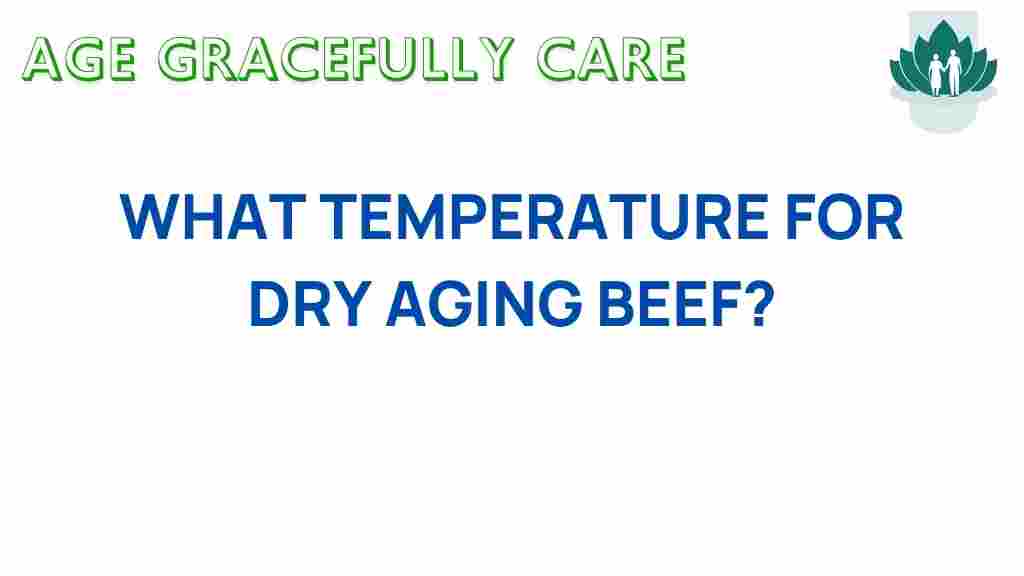Unlocking the Secrets: What Temperature is Ideal for Dry Aging Beef?
Dry aging beef is a culinary technique that has gained immense popularity among gourmet chefs and food enthusiasts alike. This process enhances the flavor and tenderness of beef, making it a sought-after choice for high-end dining experiences. However, achieving the perfect dry-aged beef requires an understanding of various factors, particularly the ideal temperature for dry aging. In this article, we will delve into the specifics of dry aging, the aging process, and how temperature plays a crucial role in meat quality and food preservation.
Understanding the Dry Aging Process
Dry aging is a controlled process that allows beef to mature in a controlled environment. The primary goal is to improve flavor and tenderness through a combination of moisture loss and natural enzymatic processes. Here’s a closer look at what happens during the dry aging process:
- Moisture Evaporation: As the beef ages, moisture evaporates from the surface, concentrating the flavor.
- Enzymatic Breakdown: Naturally occurring enzymes break down connective tissues, leading to increased tenderness.
- Flavor Development: The development of complex flavors occurs due to the growth of beneficial bacteria and molds on the meat’s surface.
Importance of Temperature in Dry Aging
The temperature at which beef is dry aged is critical to the success of the process. Too high or too low temperatures can lead to spoilage or inadequate aging. The ideal temperature for dry aging beef lies between 34°F to 38°F (1°C to 3°C). Here’s why this temperature range is crucial:
- Safety: Keeping the beef at a low temperature helps prevent the growth of harmful bacteria.
- Moisture Control: Maintaining an optimal temperature allows for a controlled evaporation of moisture, which is essential for flavor concentration.
- Flavor Development: The enzymatic activity that enhances flavor and tenderness is maximized at this temperature range.
Step-by-Step Guide to Dry Aging Beef
Now that we understand the importance of temperature in the dry aging process, let’s explore a step-by-step guide to dry aging beef properly.
Step 1: Choose the Right Cut of Beef
Not all cuts of beef are suitable for dry aging. The best choices are large, bone-in cuts that have a good amount of marbling. Popular options include:
- Bone-in ribeye
- Strip loin
- Sirloin
Step 2: Set Up Your Dry Aging Environment
To achieve the ideal temperature for dry aging, consider the following:
- Refrigerator: Use a dedicated refrigerator set to maintain the temperature between 34°F to 38°F.
- Airflow: Ensure there is good airflow around the meat to prevent spoilage. A fan can help with this.
- Humidity: Aim for a humidity level of around 80% to prevent the meat from drying out too quickly.
Step 3: Prepare the Beef
Before placing the beef in the aging environment, it should be prepared correctly:
- Trim any excess fat, but leave a good layer to protect the meat.
- Do not wash the beef; this can introduce moisture and bacteria.
Step 4: Monitor Temperature and Humidity
During the aging process, it’s crucial to monitor the temperature and humidity levels regularly. Using a digital thermometer and hygrometer can help maintain the ideal conditions for dry aging.
Step 5: Aging Duration
The duration for which you should dry age beef can vary based on personal preference:
- 21 days: Mild flavor enhancement and tenderness.
- 28 days: A noticeable improvement in flavor and tenderness.
- 45 days or more: A strong, intense flavor profile, appealing to seasoned steak lovers.
Troubleshooting Common Issues in Dry Aging
Even with careful preparation, issues can arise during the dry aging process. Here are some common problems and their solutions:
- Meat Spoilage: If the meat develops an off smell or color, it may be a sign of spoilage. Ensure your temperature is consistently maintained within the ideal range.
- Excess Drying: If the meat appears excessively dry, check your humidity levels. Increasing humidity can help retain moisture.
- Bacterial Growth: A white film may develop on the meat’s surface. While some molds are harmless, if you notice green or black molds, it’s best to discard the meat.
Conclusion: The Art of Dry Aging Beef
Dry aging beef is an art that combines science, culinary techniques, and an understanding of food preservation. By carefully controlling the temperature during the aging process, you can unlock the full potential of meat quality and flavor. Whether you are a home cook looking to elevate your culinary skills or a professional chef aiming to impress your diners, mastering the ideal temperature for dry aging beef will undoubtedly enrich your cooking repertoire.
For more tips on enhancing your culinary techniques, check out our comprehensive guide on gourmet cooking. Remember, the key to delicious dry-aged beef lies in patience, precision, and the perfect environment!
To learn more about the science of food preservation, visit this resource for in-depth insights.
This article is in the category Nutrition and created by AgeGracefullyCare Team
